目录
C++面向对象的三大特性为:封装、继承、多本
C++认为万事万物都皆为对象,对象上有其属性和行为
例如:
人可以作为对象,属性有姓名、年龄、身高、体....,行为有走、跑、跳、吃饭、唱歌...车也可以作为对象,属性有轮胎、方向盘、车灯...行为有载人、放音乐、放空调...
具有相同性质的对象,我们可以抽象称为类,人属于人类,车属于车类
1. 封装
1.1 封装的意义
封装是C++面向对象三大特性之—
封装的意义:
????????将属性和行为作为一个整体,表现生活中的事物
????????将属性和行为加以权限控制
1.1.1 封装意义—
????????在设计类的时候,属性和行为写在一起,表现事物
语法:class类名{ 访问权限: 展性 / 行为 };
示例1:设计一个圆类,求圆的周长
示例代码:
#include<iostream>
using namespace std;
const double PI = 3.14;
// 设计一个圆类,求圆的周长
class Circle {
// 访问权限
public: //公共权限
// 属性
int m_r; //半径
// 行为
// 获取圆的周长
double calculateZC()
{
return 2 * PI * m_r;
}
};
int main() {
// 实例化:通过圆类 创建具体的圆(对象)
Circle c1;
// 给圆的对象的属性进行赋值
c1.m_r = 10;
cout << "圆的周长:" << c1.calculateZC() << endl;
system("pause");
return 0;
}运行结果:

?
示例2: 设计一个学生类,属性有姓名和学号,可以给姓名和学号赋值,可以显示学生的姓名和学号
示例代码:
#include<iostream>
using namespace std;
#include<string>
class Student
{
public: // 公共权限
// 成员:类中的属性和行为统一称为成员
// 属性:成员属性、成员变量
// 行为:成员函数、成员方法
string m_Name; // 属性(学生姓名)
int m_Id; // 属性(学生id)
void showStudent() // 行为:显示姓名和学号
{
cout << "姓名:" << m_Name << " 学号:" << m_Id << endl;
}
void setNameAndId(string name, int Id) // 行为:给姓名赋值
{
m_Name = name;
m_Id = Id;
}
};
int main() {
Student s; //实例化学生对象
直接给属性赋值
//s.m_Name = "张三";
//s.m_Id = 1;
// 通过行为给属性赋值
s.setNameAndId("张三",10);
//显示学生信息
s.showStudent();
system("pause");
return 0;
}1.1.2 封装意义二
????????类在设计时,可以把属性和行为放在不同的权限下,加以控制
????????访问权限有三种:
????????????????1. public? ? ? ? ? ? ? ? ?公共权限:成员 类内类外都可以访问
????????????????2. protected? ? ? ? ? ? 保护权限:成员?类内可以访问,类外不可以访问?
? ? ? ? ? ? ? ? ? ? ? ? ? ? ? ? ? ? ? ? ? ? ? ? ? ? ? ? ? ? ? ? ?子类可以访问父类中的保护内容
????????????????3. private????????????????私有权限:成员?类内可以访问,类外不可以访问
? ? ? ? ? ? ? ? ? ? ? ? ? ? ? ? ? ? ? ? ? ? ? ? ? ? ? ? ? ? ? ? ?子类可以不可以访问父类中的私有内容
1.2 struct和class区别
在C++中struct和class唯—的区别就在于默认的访问权限不同
区别:
????????struct默认权限为公共,如下代码中,无错误提示

?
????????class默认权限为私有,如下代码中,有错误提示
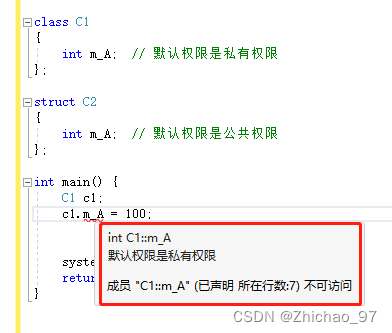
?
1.3?成员属性设置为私有
????????优点1:将所有成员属性设置为私有,可以自己控制读写权限
????????优点2:对于写权限,我们可以检测数据的有效性(判断写入的数据是否合规)
????????示例:(我想设置私有成员中的?
????????????????????????????????姓名 / 可读可写??
? ? ? ? ? ? ? ? ? ? ? ? ? ? ? ? 年龄 / 只读
? ? ? ? ? ? ? ? ? ? ? ? ? ? ? ? id / 只写
????????????????????????)
????????解决思路:
? ? ? ? 可以在公有权限中,对三个私有属性分别设置相应的成员函数,如果要可读可写,就在公有权限中编辑读和写的函数。
#include<iostream>
using namespace std;
#include<string>
class Person
{
public:
// 设置姓名(可写姓名)
void setName(string name)
{
m_Name = name;
}
// 获取姓名(可读姓名)
string getName()
{
return m_Name;
}
private:
string m_Name;
int m_age;
int id;
};
int main() {
Person p;
p.setName("张三");
cout << "姓名:" << p.getName() << endl;
system("pause");
return 0;
}2. 对象初始化和清理
????????生活中我们买的电子产品都基本会有出厂设置,在某一天我们不用时候也会删除一些自己信息数据保证安全。
????????C++中的面向对象来源于生活,每个对象也都会有初始设置以及对象销毁前的清理数据的设置。
2.1 构造函数和析构函数
????????对象的初始化和清理也是两个非常重要的安全问题
????????—个对象或者变量没有初始状态,对其使用后果是未知
????????同样的使用完一个对象或变量,没有及时清理,也会造成一定的安全问题
????????C++利用了构造函数和析构函数解决上述问题,这两个函数将会被编译器自动调用,完成对象初始化和清理工作。对象的初始化和清理工作是编译器强制要我们做的事情,因此如果我们不提供构造和析构,编译器会提供编译器提供的构造函数和析构函数是空实现。
????????构造函数:主要作用在于创建对象时为对象的成员属性赋值,构造函数由编译器自动调用,无须手动调用。
????????析构函数:主要作用在于对象销毁前系统自动调用,执行一些清理工作。
构造函数语法:????????类名(){}
????????1.构造函数,没有返回值也不写void
????????2.函数名称与类名相同
????????3.构造函数可以有参数,因此可以发生重载
????????4.程序在调用对象时候会自动调用构造,无须手动调用,而且只会调用一次
析构函数语法:????????~类名(){}
????????1.析构函数,没有返回值也不写void
????????2.函数名称与类名相同,在名称前加上符号~
????????3.析构函数不可以有参数,因此不可以发生重载
????????4.程序在对象销毁前会自动调用析构,无须手动调用,而且只会调用一次
构造函数与析构函数的使用示例:
#include<iostream>
using namespace std;
#include<string>
class Person
{
public:
// 1. 构造函数
Person()
{
cout << "Person 构造函数的调用" << endl;
}
// 2. 析构函数
~Person()
{
cout << "Person 析构函数的调用" << endl;
}
};
void test01()
{
Person p;
}
int main() {
test01();
system("pause");
return 0;
}2.2 构造函数的分类及调用
两种分类方式:
????????按参数分为:有参构造和无参构造
????????按类型分为:普通构造和拷贝构造
三种调用方式:
????????括号法
????????显示法
????????隐式转换法
2.3 拷贝构造函数调用时机
C++中拷贝构造函数调用时机通常有三种情况
? ? ? ? 1.使用一个已经创建完毕的对象来初始化一个新对象
? ? ? ? 2.值传递的方式给函数参数传值
? ? ? ? 3.以值方式返回局部对象
2.4 构造函数调用规则
默认情况下,c++编译器至少给一个类添加3个函数
????????1.默认构造函数(无参,函数体为空)
????????2.默认析构函数(无参,函数体为空)
????????3.默认拷贝构造函数,对属性进行值拷贝
构造函数调用规则如下:
????????1.如果用户定义有参构造函数,c++不在提供默认无参构造,但是会提供默认拷贝构造
????????2.如果用户定义拷贝构造函数,C++不会再提供其他构造函数
2.5 深拷贝与浅拷贝
浅拷贝:简单的赋值拷贝操作
深拷贝:在堆区重新申请空间,进行拷贝操作
?
2.6 初始化列表
作用:C++提供了初始化列表语法,用来初始化属性
语法:构造函数():属性1(值1) ,属性2(值2) ... {}
传统初始化操作:通过构造函数初始化属性
#include<iostream>
using namespace std;
#include<string>
class Person
{
public:
// 传统初始化操作:通过构造函数初始化属性
Person(int a, int b, int c)
{
m_A = a;
m_B = b;
m_C = c;
}
int m_A;
int m_B;
int m_C;
};
void test01()
{
Person p(10, 20, 30);
cout << "m_A = " << p.m_A << endl;
cout << "m_B = " << p.m_B << endl;
cout << "m_C = " << p.m_C << endl;
}
int main() {
test01();
system("pause");
return 0;
}通过初始化列表:
#include<iostream>
using namespace std;
#include<string>
class Person
{
public:
Person():m_A(10),m_B(10),m_C(30)
{
}
int m_A;
int m_B;
int m_C;
};
void test01()
{
Person p;
cout << "m_A = " << p.m_A << endl;
cout << "m_B = " << p.m_B << endl;
cout << "m_C = " << p.m_C << endl;
}
int main() {
test01();
system("pause");
return 0;
}2.7 类对象作为类成员
????????C++类中的成员可以是另一个类的对象,我们称该成员为对象成员
例如:
class A {}
class B
{
A a;
}????????B类中有对象A作为成员,A为对象成员,那么当创建B对象时,A与B的构造和析构的顺序是谁先谁后?
????????答案:是A先构造
2.8 静态成员
静态成员就是在成员变呈和成员函数前加上关键字static,称为静态成员
静态成员分为:
????????静态成员变量
????????????????所有对象共享同一份数据
????????????????在编译阶段分配内存
????????????????类内声明,类外初始化
????????????????(静态成员变量也是有访问权限的,如私有权限的静态成员变量在类外是访问不到的)
????????静态成员函数
????????????????所有对象共享同一个函数
????????????????静态成员函数只能访问静态成员变量
以下示例代码证明了所有对象共享一份数据:
#include<iostream>
using namespace std;
#include<string>
class Person
{
public:
static int m_A; // 类内申明
};
int Person::m_A = 100; // 类外初始化
void test01()
{
Person p;
cout << "p的 m_A = " << p.m_A << endl;
Person p2;
p2.m_A = 200;
cout << "p2的 m_A = " << p.m_A << endl;
}
int main() {
test01();
system("pause");
return 0;
}结果:

?
因此静态成员变量有两种访问方式:
1.通过对象进行访问
Person p;
cout << p.m_A << endl;2.通过类名访问
cout << Person::m_A << endl;以下示例代码呈现了静态成员函数的两种访问方式
#include<iostream>
using namespace std;
#include<string>
class Person
{
public:
static void func()
{
cout << "调用func" << endl;
}
};
void test01()
{
// 通过对象访问
Person p;
p.func();
// 通过类名访问
Person::func();
}
int main() {
test01();
system("pause");
return 0;
}3. C++对象模型和this指针
3.1 成员变量和成员函数分开存储
在C++中,类内的成员变量和成员函数分开存储
只有非静态成员变量才属于类的对象上
3.2 this指针概念
通过3.1我们知道在C++中成员变虽和成员函数是分开存储的
每一个非静态成员函数只会诞生一份函数实例,也就是说多个同类型的对象会共用一块代码
那么问题是:这一块代码是如何区分哪个对象调用自己的呢?
C++通过提供特殊的对象指针,this指针,解决上述问题。this指针指向被调用的成员函数所属的对象
this指针是隐含每一个非静态成员函数内的一种指针
this指针不需要定义,直接使用即可
this指针的用途:
????????1.当形参和成员变量同名时,可用this指针来区分
#include<iostream>
using namespace std;
#include<string>
class Person
{
public:
Person(int age)
{
// this指针指向被调用的成员函数 所属的对象
this->age = age;
}
int age;
};
void test01()
{
Person p1(18);
cout << "p1的年龄" << p1.age << endl;
}
int main() {
test01();
system("pause");
return 0;
} ?
?
????????2.在类的非静态成员函数中返回对象本身,可使用return *this
3.3 空指针访问成员函数
C++中空指针也是可以调用成员函数的,但是也要注意有没有用到this指针
如果用到this指针,需要加以判断保证代码的健壮性
错误写法:
#include<iostream>
using namespace std;
#include<string>
class Person
{
public:
void showClassName()
{
cout << "show class name" << endl;
}
void showPersonAge()
{
cout << "age = " << this->m_Age << endl;
}
int m_Age;
};
void test01()
{
Person * p = NULL;
//p->showClassName();
p->showPersonAge();
}
int main() {
test01();
system("pause");
return 0;
}
?报错原因是因为传入的指针是为NULL
正确写法:
#include<iostream>
using namespace std;
#include<string>
class Person
{
public:
void showClassName()
{
cout << "show class name" << endl;
}
void showPersonAge()
{
if (this == NULL)
{
return;
}
cout << "age = " << this->m_Age << endl;
}
int m_Age;
};
void test01()
{
Person * p = NULL;
//p->showClassName();
p->showPersonAge();
}
int main() {
test01();
system("pause");
return 0;
}3.4 const修饰成员函数
常函数:
1.成员函数后加const后我们称为这个函数为常函数(在成员函数后面加const,修饰的是this指向,让指针指向的值也不可以修改)
2.常函数中不可以修改成员属性
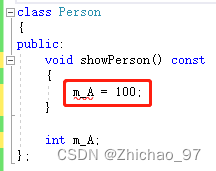 ?
?
3.成员属性声明时加关捷字mutable后,在常函数中依然可以修改
常对象:
1.声明对象前加const称该对象为常对象
const Person p;2.常对象只能调用常函数
?
#include<iostream>
using namespace std;
#include<string>
class Person
{
public:
void showPerson(int num) const
{
m_A = num;
}
mutable int m_A;
};
void test01()
{
const Person p;
p.showPerson(100);
cout << p.m_A << endl;
}
int main() {
test01();
system("pause");
return 0;
}
?
4.4 友元
????????生活中你的家有客厅(Public),有你的卧室(Private),客厅所有来的客人都可以进去,但是你的卧室是私有的,也就是说只有你能进去但是呢,你也可以允许你的好闰蜜好基友进去。
????????在程序里,有些私有属性也想让类外特殊的一些函数或者类进行访问,就需要用到友元的技术,友元的目的就是让—个函数或者类访问另一个类中私有成员,友元的关键字为friend。
友元的三种实现
????????1.全局函数做友元
????????2.类做友元
????????3.成员函数做友元
4.4.1 全局函数做友元
#include<iostream>
using namespace std;
#include<string>
class Building
{
friend void goodFriend(Building *building); //表示goodFriend全局函数是本类的友元,可以访问本类的私有属性
public:
Building()
{
m_SittingRoom = "客厅";
m_BedRoom = "卧室";
}
public:
string m_SittingRoom;
private:
string m_BedRoom;
};
void goodFriend(Building *building)
{
cout << "goodFriend 正在访问:" << building->m_BedRoom << endl;
}
void test01()
{
Building building;
goodFriend(&building);
}
int main() {
test01();
system("pause");
return 0;
}
?
4.4.2 类做友元
#include<iostream>
using namespace std;
#include<string>
class Building;
class goodFriend
{
public:
goodFriend();
void visit(); //用来访问Building中的属性
Building * building;
};
class Building
{
friend class goodFriend; //表示goodFriend类是Building类的友元,可以访问Building中的私有成员
public:
Building();
public:
string m_SittingRoom;
private:
string m_BedRoom;
};
// 类外写成员函数
Building::Building() //Building的构造函数
{
m_SittingRoom = "客厅";
m_BedRoom = "卧室";
}
goodFriend::goodFriend() //goodFriend的构造函数
{
// 创建building对象
building = new Building;
}
void goodFriend::visit()
{
cout << "goodFriend类正在访问:" << building->m_SittingRoom << endl;
cout << "goodFriend类正在访问:" << building->m_BedRoom << endl;
}
void test01()
{
goodFriend gg;
gg.visit();
};
int main() {
test01();
system("pause");
return 0;
}
?
4.4.3 成员函数做友元
#include<iostream>
using namespace std;
#include<string>
class Building;
class goodFriend
{
public:
goodFriend(); //申明构造函数
void visit(); //让visit函数可以访问Building中的私有成员
Building * building;
};
class Building
{
friend void goodFriend::visit(); //让goodFriend类中的visit成员函数作为本类的友元
public:
Building(); //申明构造函数
public:
string m_SitingRoom;
private:
string m_BedRoom;
};
//类外实现成员函数
Building::Building()
{
m_SitingRoom = "客厅";
m_BedRoom = "卧室";
}
goodFriend::goodFriend()
{
building = new Building;
}
void goodFriend::visit()
{
cout << "visit函数正在访问:" << building->m_SitingRoom << endl;
cout << "visit函数正在访问:" << building->m_BedRoom << endl;
}
void test01()
{
goodFriend gg;
gg.visit();
};
int main() {
test01();
system("pause");
return 0;
}
?
5. 运算符重载
????????运算符重载概念:对已有的运算符重新进行定义,赋予其另一种功能,以适应不同的数据类型
加号运算法重载
作用:实现两个自定义数据类型相加的运算
方式1:通过成员函数重载+号?
#include<iostream>
using namespace std;
#include<string>
class Person
{
public:
Person operator+(Person &p)
{
Person temp;
temp.m_A = this->m_A + p.m_A;
temp.m_B = this->m_B + p.m_B;
return temp;
}
int m_A;
int m_B;
};
void test01()
{
Person p1;
p1.m_A = 10;
p1.m_B = 10;
Person p2;
p2.m_A = 10;
p2.m_B = 10;
Person p3 = p1 + p2;
//Person p3 = p1.operator+(p2); // 成员函数重载本质调用
cout << "p3.m_A = " << p3.m_A << endl;
cout << "p3.m_B = " << p3.m_B << endl;
};
int main() {
test01();
system("pause");
return 0;
}方式2:通过全局函数重载+号?
#include<iostream>
using namespace std;
#include<string>
class Person
{
public:
int m_A;
int m_B;
};
Person operator+(Person &p1, Person &p2)
{
Person temp;
temp.m_A = p1.m_A + p2.m_A;
temp.m_B = p1.m_B + p2.m_B;
return temp;
}
void test01()
{
Person p1;
p1.m_A = 10;
p1.m_B = 10;
Person p2;
p2.m_A = 10;
p2.m_B = 10;
Person p3 = p1 + p2;
// Person p3 = operator+(p1, p2) // 全局函数重载本质调用
cout << "p3.m_A = " << p3.m_A << endl;
cout << "p3.m_B = " << p3.m_B << endl;
};
int main() {
test01();
system("pause");
return 0;
}6. 继承
继承是面向对象三大特性之一
有些类与类之间存在特殊的关系,例如下图中:

?????????我们发现,定义这些类时,下级别的成员除了拥有上一级的共性,还有自己的特性。这个时候我们就可以考虑利用继承的技术,减少重复代码。
6.1 继承的基本使用
不使用继承(重复代码太多):
#include<iostream>
using namespace std;
#include<string>
class Java
{
public:
void header()
{
cout << "header" << endl;
}
void footer()
{
cout << "footer" << endl;
}
void content()
{
cout << "---Java---" << endl;
}
};
class Python
{
public:
void header()
{
cout << "header" << endl;
}
void footer()
{
cout << "footer" << endl;
}
void content()
{
cout << "---Python---" << endl;
}
};
void test01()
{
Java ja;
ja.footer();
ja.header();
ja.content();
Python py;
py.footer();
py.header();
py.content();
};
int main() {
test01();
system("pause");
return 0;
}使用继承:
#include<iostream>
using namespace std;
#include<string>
//继承实现
class Base
{
public:
void header()
{
cout << "header" << endl;
}
void footer()
{
cout << "footer" << endl;
}
};
class Java :public Base
{
public:
void content()
{
cout << "---Java---" << endl;
}
};
class Python :public Base
{
public:
void content()
{
cout << "---Python---" << endl;
}
};
void test01()
{
Java ja;
ja.footer();
ja.header();
ja.content();
Python py;
py.footer();
py.header();
py.content();
};
int main() {
test01();
system("pause");
return 0;
}6.2 继承方式
继承的语法:? class子类:继承方式? 父类
继承方式一共有三种:
????????1.公共继承
????????2.保护继承·
????????3.私有继承
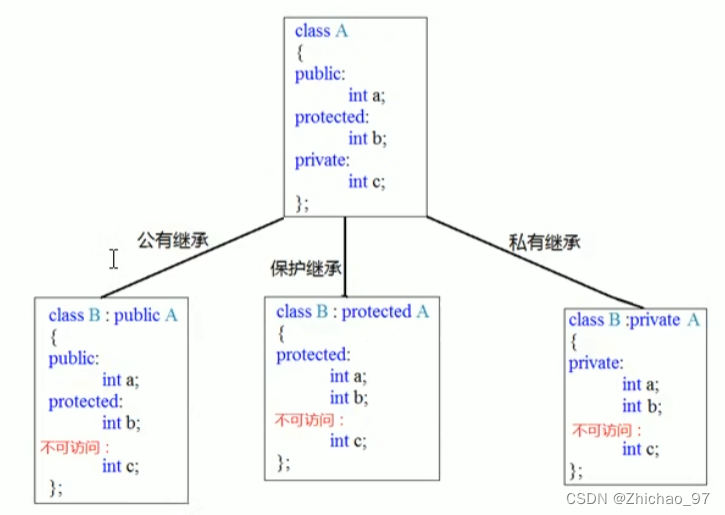
?
6.3 继承中构造和析构顺序
子类继承父类后,当创建子类对象,也会调用父类的构造函数
问题:父类和子类的构造和析构顺序是谁先谁后?
?
#include<iostream>
using namespace std;
#include<string>
//继承实现
class Base
{
public:
Base()
{
cout << "Base构造函数!" << endl;
}
~Base()
{
cout << "Base析构函数!" << endl;
}
};
class Son :public Base
{
public:
Son()
{
cout << "Son构造函数!" << endl;
}
~Son()
{
cout << "Son析构函数!" << endl;
}
};
void test01()
{
Son s;
};
int main() {
test01();
system("pause");
return 0;
}
?
6.4 继承同名成员处理方式
问题:当子类与父类出现同名的成员,如何通过子类对象,访问到子类或父类中同名的数据呢?
? ? ? ? 方式1:访问子类同名成员直接访问即可
? ? ? ? 方式2:访问父类同名成员需要加作用域
6.4.1 同名成员变量的处理方式
#include<iostream>
using namespace std;
#include<string>
//继承实现
class Base
{
public:
Base()
{
m_A = 100;
}
int m_A;
};
class Son :public Base
{
public:
Son()
{
m_A = 200;
}
int m_A;
};
void test01()
{
Son s;
cout << "Son m_A = " << s.m_A << endl; // 访问子类中的m_A
cout << "Base m_A = " << s.Base::m_A << endl; // 访问父类中的m_A
};
int main() {
test01();
system("pause");
return 0;
}
?
6.4.2 同名成员函数的处理方式
#include<iostream>
using namespace std;
#include<string>
//继承实现
class Base
{
public:
void func()
{
cout << "调用Base的func" << endl;
}
};
class Son :public Base
{
public:
void func()
{
cout << "调用Son的func" << endl;
}
};
void test01()
{
Son s;
s.func(); // 直接调用,调用的是子类中同名的成员函数
s.Base::func(); // 调用父类中的func
};
int main() {
test01();
system("pause");
return 0;
}6.5 继承同名静态成员处理方式
问题:继承承中同名的静态成员在子类对象上如何进行访问?
静态成员和非静态成员出现同名,处理方式一致
????????访问子类同名成员直接访问即可
????????访问父类同名成员需要加作用域
6.5.1 同名静态成员属性
#include<iostream>
using namespace std;
#include<string>
//继承实现
class Base
{
public:
static int m_A; // 类内申明
};
int Base::m_A = 100; //类外初始化
class Son :public Base
{
public:
static int m_A;
};
int Son::m_A = 200;
// 同名静态成员属性
void test01()
{
// 通过对象访问
Son s;
cout << "Son的m_A = " << s.m_A << endl;
cout << "Base的m_A = " << s.Base::m_A << endl;
// 通过类名访问
cout << "Son的m_A = " << Son::m_A << endl;
cout << "Base的m_A = " << Son::Base::m_A << endl; // 第一个::代表通过类名方式访问, 第二个::代表访问父类作用域下
};
int main() {
test01();
system("pause");
return 0;
}6.5.2 同名静态成员函数
#include<iostream>
using namespace std;
#include<string>
//继承实现
class Base
{
public:
static void func()
{
cout << "Base static void func()" << endl;
}
};
class Son :public Base
{
public:
static void func()
{
cout << "Son static void func()" << endl;
}
};
// 同名静态成员函数
void test02()
{
Son s;
s.func(); // 调用子类的func
s.Base::func(); // 调用父类的func
}
int main() {
test02();
system("pause");
return 0;
}6.6?多继承语法
C++允许一个类继承多个类
语法: class子类︰继承方式父类1,继承方式父类2...
多继承可能会引发父类中有同名成员出现,需要加作用域区分
C++实际开发中不建议用多继承
#include<iostream>
using namespace std;
#include<string>
class Base1
{
public:
Base1()
{
m_A = 100;
}
int m_A;
};
class Base2
{
public:
Base2()
{
m_B = 200;
}
int m_B;
};
class Son:public Base1, public Base2
{
public:
Son()
{
m_C = 300;
m_D = 400;
}
int m_C;
int m_D;
};
// 同名静态成员函数
void test01()
{
Son s;
cout << s.Base1::m_A << endl;
cout << s.Base2::m_B << endl;
cout << s.m_C << endl;
}
int main() {
test01();
system("pause");
return 0;
}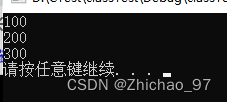
6.7 菱形继承
菱形继承概念:
????????两个派生类继承同一个基类
????????又有某个类同时继承者两个派生类
????????这种继承被称为菱形继承,或者钻石继承
?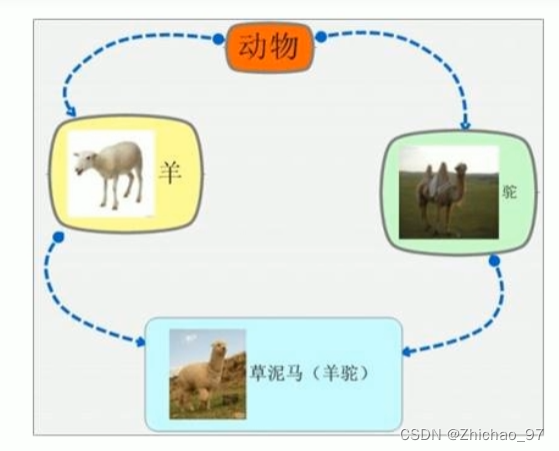
?菱形继承问题:
????????1.羊继承了动物的数据,驼同样继承了动物的数据,当草泥马使用数据时,就会产生二义性。
可以用作用域加以区分:?
#include<iostream>
using namespace std;
#include<string>
class Animal
{
public:
int m_Age;
};
class Sheep : public Animal {};
class Tuo : public Animal {};
class SheepTuo : public Sheep, public Tuo {};
// 同名静态成员函数
void test01()
{
SheepTuo st;
st.Sheep::m_Age = 18;
st.Tuo::m_Age = 28;
// 当菱形继承,两个父类拥有相同成员属性时,可以用作用域加以区分
cout << "st.Sheep::m_Age = " << st.Sheep::m_Age << endl;
cout << "st.Tuo::m_Age = " << st.Tuo::m_Age << endl;
}
int main() {
test01();
system("pause");
return 0;
} ??
??
????????⒉草泥马继承自动物的数据继承了两份,其实我们应该清楚,这份数据我们只需要一份就可以。
利用虚继承 解决菱形继承的问题:
#include<iostream>
using namespace std;
#include<string>
class Animal
{
public:
int m_Age;
};
// 利用虚继承 解决菱形继承的问题
class Sheep : virtual public Animal {};
class Tuo : virtual public Animal {};
class SheepTuo : virtual public Sheep, public Tuo {};
// 同名静态成员函数
void test01()
{
SheepTuo st;
st.Sheep::m_Age = 18;
st.Tuo::m_Age = 28;
// 当菱形继承,两个父类拥有相同成员属性时,可以用作用域加以区分
cout << "st.Sheep::m_Age = " << st.Sheep::m_Age << endl;
cout << "st.Tuo::m_Age = " << st.Tuo::m_Age << endl;
cout << st.m_Age << endl;
}
int main() {
test01();
system("pause");
return 0;
}
?
7. 多态
7.1 多态的基本概念
多态是C++面向对象三大特性之—
多态分为两类:
????????静态多态:函数重载和运算符重载属于静态多态,复用函数名
????????动态多态:派生类和虚函数实现运行时多态
静态多态和动态多态区别:
????????静态多态的函数地址早绑定 – 编译阶段确定函数地址
????????动态多态的函数地址晚绑定 – 运行阶段确定函数地址
总结:
????????多态满足条件:
????????????????有继承关系
????????????????子类重写父类中的虚函数
????????多态使用条件:
????????????????父类指针或引用指向子类对象
????????重写:函数返回值类型函数名参数列表完全一致称为重写
下面通过案例进行讲解多态:
#include<iostream>
using namespace std;
#include<string>
class Animal
{
public:
void speak()
{
cout << "Animal speak" << endl;
}
};
class Cat :public Animal
{
public:
void speak()
{
cout << "Cat speak" << endl;
}
};
// 同名静态成员函数
void doSpeak(Animal &animal) // 地址早绑定,在编译阶段确定函数地址
{
animal.speak();
}
void test01()
{
Cat cat;
doSpeak(cat);
}
int main() {
test01();
system("pause");
return 0;
}
????????发现想让猫说话,但是执行的是动物说话。原因是地址早绑定,在编译阶段确定函数地址。
????????如果想执行让猫说话,那么这个函数地址就不能提前绑定,需要在运行阶段进行绑定,即地址晚绑定,通过关键字 virtual 实现:
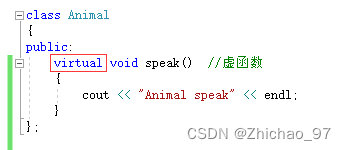
#include<iostream>
using namespace std;
#include<string>
class Animal
{
public:
virtual void speak() //虚函数
{
cout << "Animal speak" << endl;
}
};
class Cat :public Animal
{
public:
void speak()
{
cout << "Cat speak" << endl;
}
};
class Dog :public Animal
{
public:
void speak()
{
cout << "Dog speak" << endl;
}
};
// 同名静态成员函数
void doSpeak(Animal &animal) // 地址早绑定,在编译阶段确定函数地址
{
animal.speak();
}
void test01()
{
Cat cat;
doSpeak(cat);
Dog dog;
doSpeak(dog);
}
int main() {
test01();
system("pause");
return 0;
}
?
7.2 多态案例一计算器类
案例描述:
分别利用普通写法和多态技术,设计实现两个操作数进行运算的计算器类
多态的优点:
????????代码组织结构清晰
????????可读性强
????????利于前期和后期的扩展以及维护
普通写法:
#include<iostream>
using namespace std;
#include<string>
class Calculate
{
public:
int getResult(string oper)
{
if (oper == "+")
{
return m_Num1 + m_Num2;
}
else if (oper == "-")
{
return m_Num1 - m_Num2;
}
else if (oper == "*")
{
return m_Num1 * m_Num2;
}
}
int m_Num1;
int m_Num2;
};
void test01()
{
// 创建计算器对象
Calculate c;
c.m_Num1 = 10;
c.m_Num2 = 20;
cout << c.m_Num1 << " + " << c.m_Num2 << " = " << c.getResult("+") << endl;
cout << c.m_Num1 << " - " << c.m_Num2 << " = " << c.getResult("-") << endl;
cout << c.m_Num1 << " * " << c.m_Num2 << " = " << c.getResult("*") << endl;
}
int main() {
test01();
system("pause");
return 0;
}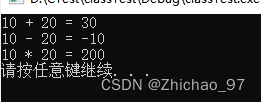 ?
?
多态写法:
#include<iostream>
using namespace std;
#include<string>
// 利用多态实现计算器
//实现计算器抽象类
class AbstractCalculator
{
public:
virtual int getResult()
{
return 0;
}
int m_Num1;
int m_Num2;
};
//加法计算器类
class AddCalculator :public AbstractCalculator
{
public:
int getResult() //子类重写父类中的虚函数
{
return m_Num1 + m_Num2;
}
};
//减法计算器类
class SubCalculator :public AbstractCalculator
{
public:
int getResult()
{
return m_Num1 - m_Num2;
}
};
//乘法计算器类
class MulCalculator :public AbstractCalculator
{
public:
int getResult()
{
return m_Num1 * m_Num2;
}
};
void test02()
{
//多态使用条件
//父类指针或者引用指向子类对象
//加法运算
AbstractCalculator * abc = new AddCalculator; //父类指针指向子类对象
abc->m_Num1 = 10;
abc->m_Num2 = 20;
cout << abc->m_Num1 << " + " << abc->m_Num2 << " = " << abc->getResult() << endl;
delete abc; //销毁指针
//减法运算
abc = new SubCalculator;
abc->m_Num1 = 100;
abc->m_Num2 = 200;
cout << abc->m_Num1 << " - " << abc->m_Num2 << " = " << abc->getResult() << endl;
delete abc;
//乘法运算
abc = new MulCalculator;
abc->m_Num1 = 5;
abc->m_Num2 = 15;
cout << abc->m_Num1 << " * " << abc->m_Num2 << " = " << abc->getResult() << endl;
delete abc;
}
int main() {
test02();
system("pause");
return 0;
}?
?
7.3 纯虚函数和抽象类
在多态中,通常父类中虚函数的实现是毫无意义的,主要都是调用子类重写的内容
因此可以将虚函数改为纯虚函数
纯虚函数语法:virtual 返回值类型 函数名 (参数列表) = 0;
当类中有了纯虚函数,这个类也称为抽象类
#include<iostream>
using namespace std;
class Base
{
public:
// 只要类中有一个纯虚函数,这个类就称为抽象类
virtual void func() = 0;
};
int main() {
system("pause");
return 0;
}抽象类特点:
? ? ? ?1. 无法实例化对象
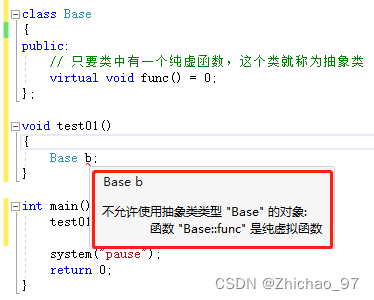
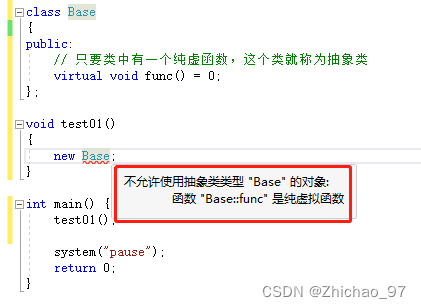
?
? ? ? ? 2. 子类必须重写抽象类中的纯虚函数,否则也属于抽象类

????????????????????????????????子类重写抽象类中的纯虚函数才能实例化:
#include<iostream>
using namespace std;
#include<string>
class Base
{
public:
virtual void func() = 0;
};
class Son :public Base
{
public:
virtual void func() {}
};
void test01()
{
//Son s;
Base * base = new Son;
base->func();
}
int main() {
test01();
system("pause");
return 0;
}?
7.4 多态案例二:制作饮品
制作饮品的大致流程为:煮水-冲泡-倒入杯中-加入辅料
利用多态技术实现本案例,提供抽象制作饮品基类,提供子类制作咖啡和茶叶
#include<iostream>
using namespace std;
#include<string>
class AbstractMakeDrinking
{
public:
virtual void Boil() = 0; //煮水
virtual void Brew() = 0; //冲泡
virtual void PourInCup() = 0; //倒入杯中
virtual void PutSomeThing() = 0; //加入辅料
void makeDirnk() //只要一调用makeDirnk,就会执行这4个步骤
{
Boil();
Brew();
PourInCup();
PutSomeThing();
}
};
class MakeCoffee:public AbstractMakeDrinking
{
public:
virtual void Boil()
{
cout << "煮水" << endl;
}
virtual void Brew()
{
cout << "冲泡" << endl;
}
virtual void PourInCup()
{
cout << "倒入水中" << endl;
}
virtual void PutSomeThing()
{
cout << "加入牛奶" << endl;
}
};
class MakeTea :public AbstractMakeDrinking
{
public:
virtual void Boil()
{
cout << "煮水" << endl;
}
virtual void Brew()
{
cout << "冲泡" << endl;
}
virtual void PourInCup()
{
cout << "倒入水中" << endl;
}
virtual void PutSomeThing()
{
cout << "加入柠檬" << endl;
}
};
void doWork(AbstractMakeDrinking * abs)
{
abs->makeDirnk();
delete abs; //释放指针(在堆区)
}
void test01()
{
doWork(new MakeCoffee);
cout << "————————" << endl;
doWork(new MakeTea);
}
int main() {
test01();
system("pause");
return 0;
}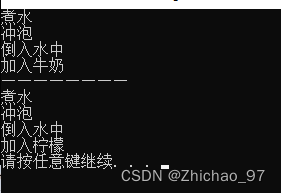
?
7.5 虚析构和纯虚析构
多态使用时,如果子类中有属性开辟到堆区,那么父类指针在释放时无法调用到子类的析构代码
#include<iostream>
using namespace std;
#include<string>
class Animal
{
public:
Animal()
{
cout << "调用Animal构造函数" << endl;
}
~Animal()
{
cout << "调用Animal析构函数" << endl;
}
virtual void speak() = 0; //纯虚函数
};
class Cat :public Animal
{
public:
Cat(string name)
{
m_Name = new string(name);
}
virtual void speak()
{
cout << *m_Name << "小猫在说话" << endl;
}
~Cat()
{
if (m_Name != NULL)
{
cout << "调用Cat析构函数" << endl;
delete m_Name;
m_Name = NULL;
}
}
string * m_Name;
};
void test01()
{
Animal * animal = new Cat("Tom");
animal->speak();
delete animal;
}
int main() {
test01();
system("pause");
return 0;
}?
发现没有调用Cat的析构函数
????????原因:父指针在析构时候,不会调用子类中的析构函数,导致子类如果有堆区属性,会出现内存泄露情况。
????????解决方式:将父类中的析构函数改为虚析构或者纯虚析构
1. 使用虚析构方式:
将
~Animal()
{
cout << "调用Animal析构函数" << endl;
}改为
virtual ~Animal()
{
cout << "调用Animal析构函数" << endl;
}?2. 纯虚析构
class Animal
{
public:
Animal()
{
cout << "调用Animal构造函数" << endl;
}
virtual ~Animal() = 0; //纯虚析构
virtual void speak() = 0; //纯虚函数
};
Animal::~Animal()
{
cout << "调用Animal纯虚析构函数" << endl;
}虚析构和纯虚析构共性:
????????1.可以解决父类指针释放子类对象
????????2.都需要有具体的函数实现
虚析构和纯虚析构区别:
????????如果是纯虚析构,该类属于抽象类,无法实例化对象